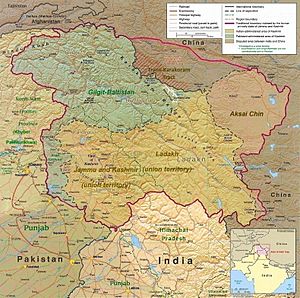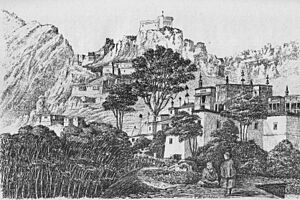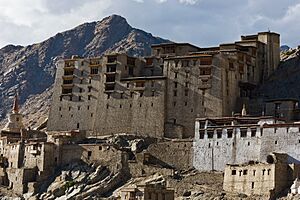History of Ladakh facts for kids
Ladakh is a special place with a very long history. People have lived here for at least 9,000 years! For thousands of years, Ladakh has been a meeting point for different cultures across Asia. Many ideas, empires, and technologies from nearby lands have influenced Ladakh. This mix of traditions has created a unique culture and way of life.
Contents
Ancient History of Ladakh
The first signs of Ladakh's political history come from an old writing found near the Indus River. This writing, from around the 1st century, shows that Ladakh was once part of the Kushan Empire. Other ancient writings have also been found in the area.
In the 7th century, a Chinese monk named Xuanzang traveled through this region. He described a place called Marsa, which is likely the same as Mar-yul, a common name for Ladakh. At this time, the Zhangzhung kingdom, which included parts of Ladakh, became connected to Tibet.
In the 8th century, Ladakh was caught between the growing power of Tibet from the east and China from Central Asia. In 737, Tibet attacked the king of Gilgit, who asked China for help. But he eventually had to accept Tibetan rule. A Korean monk named Hyecho wrote that in the early 8th century, the Ladakh region was under Tibetan control. He also noted that the people were not Tibetan and followed Buddhist teachings.
After a Chinese general's campaign in 747, China's influence in the region lessened. Tibetan influence then grew stronger again. Around 982, an old book called Hudud-al-Alam mentioned a part of Tibet called Bolorian (which included Baltistan). It said that people there were mainly traders and lived in simple huts. Ancient crosses and Arabic writings found in the area show how important trade was in Ladakh. When the Tibetan monarchy fell in 842, Tibet's control over Ladakh ended.
The First Dynasty: La-Chen/Gon
After the Tibetan Empire broke apart in 842, a new leader named Nyima-Gon started the first dynasty of Ladakh. He was from the old Tibetan royal family. His kingdom was located east of today's Ladakh. During this time, Ladakh became more like Tibet, with many people having mixed Tibetan backgrounds.
However, this new dynasty wanted to spread Buddhism. They looked to northwest India, especially Kashmir, for guidance, not Tibet. This period is known as the "Second Spreading of Buddhism" in the region. An early king, Lde-dpal-hkhor-btsan (around 870-900), promised to support the Bön religion in Ladakh. He built eight early monasteries and encouraged the creation of many religious texts.
Later, a king named Lhachen Utpala (who had a Sanskrit name) conquered areas like Kullu, Mustang, and parts of Baltistan. Around the 13th century, as Islamic groups expanded in India, Ladakh started to get its religious guidance from Tibet instead.
The Namgyal Dynasty
Ladakh faced many attacks from groups in Central Asia. These attacks weakened Ladakh and led to some people converting to Islam. Ladakh became divided. Lower Ladakh was ruled by King Takpabum from Basgo and Temisgam. Upper Ladakh was ruled by King Takbumde from Leh and Shey.
Later, a Basgo king named Lhachen Bhagan reunited Ladakh by taking over Leh. He took the name Namgyal, which means "victorious," and started a new royal family that still exists today. King Tashi Namgyal (1555–1575) fought off most of the Central Asian attackers. He also built a royal fort on top of Namgyal Peak. Another king, Tsewang Namgyal, briefly made his kingdom stretch as far as Nepal.
During the rule of Jamyang Namgyal, Ladakh was invaded by the Balti ruler Ali Sher Khan Anchan. Many Buddhist temples, called gompas, were damaged during this invasion. Because of this, few gompas from before this time still exist today. Jamyang Namgyal made a peace treaty and married Ali Sher Khan's daughter. Jamyang also married a Muslim princess named Gyal Khatun.
Their son, Sengge Namgyal (1616–1642), was known as the "lion king." He worked hard to bring Ladakh back to its former glory. He started a big building program, rebuilding many gompas and shrines. The most famous one he rebuilt is Hemis. He also moved the royal capital from Shey Palace to Leh Palace. Sengge Namgyal expanded his kingdom into Zanskar and Spiti. However, he was defeated by the Mughals, who had already taken over Kashmir and Baltistan.
His son, Deldan Namgyal (1642–1694), had to please the Mughal emperor Aurangzeb by building a mosque in Leh. Later, with the help of the Mughal army, he defeated an invasion from the 5th Dalai Lama of Tibet. During this time, many Muslim teachers came to Ladakh and some Ladakhis converted to Islam. Many Balti Muslims also settled in Leh after Jamyang Namgyal's marriage. Muslims were also invited to the region for trade.
Ladakh in Modern Times
Ladakh as a Princely State
By the early 1800s, the Mughal Empire had fallen apart. The Sikhs had taken control of Punjab and Kashmir. However, the Dogra region of Jammu was still ruled by its own Rajput kings. In 1834, Raja Gulab Singh of Jammu, who was under the Sikh ruler Ranjit Singh, sent his general Zorawar Singh to invade Ladakh. King Tshespal Namgyal was removed from power and sent away to Stok.
Ladakh then came under Dogra rule and later became part of the princely state of Jammu and Kashmir. This state was under British control. Ladakh still had a lot of freedom and kept its connections with Tibet. During the Dogra–Tibetan War (1841–42), Tibet invaded Ladakh. The Ladakhis tried to overthrow the Dogras with Tibetan help, but they were all defeated. The Namgyal royal family was given the area of Stok to rule, which they still have today.
European influence began to grow in Ladakh in the 1850s. Geologists, sports enthusiasts, and tourists started exploring the region. In 1885, Leh became the main center for a mission of the Moravian Church. During Dogra rule, Ladakh was managed as a wazarat, led by a governor called wazir-e-wazarat. It had three main areas: Leh, Skardu, and Kargil. The main office for the wazarat moved between Leh and Skardu every six months.
Ladakh as Part of Jammu and Kashmir (Indian State)
In 1947, when India was divided, Ladakh became part of the Indian state of Jammu and Kashmir. It was managed from Srinagar. In 1948, Pakistani raiders attacked Ladakh and took over Kargil and Zanskar, getting very close to Leh. Indian troops were sent by air, and a group of Gurkhas walked slowly to Leh from the south. Kargil saw more fighting in 1965, 1971, and 1999.
In 1949, China closed the border between Nubra and Xinjiang, stopping a 1,000-year-old trade route. In 1950, China invaded Tibet, and thousands of Tibetans, including the Dalai Lama, came to India for safety. In 1962, China took control of Aksai Chin. They quickly built roads connecting Xinjiang and Tibet, and the Karakoram Highway with Pakistan. India also built the Srinagar-Leh highway during this time, cutting the travel time from 16 days to just two. At the same time, China closed the Ladakh-Tibet border, ending a 700-year-old connection.
Since the early 1960s, more Tibetans have come to Ladakh, fleeing Chinese rule in their homeland. Today, Leh has about 3,500 Tibetan refugees. Many Ladakhis have not been fully happy with being governed by the state government in Srinagar. They want Ladakh to be directly governed by New Delhi as a Union Territory. They say the state government has been unfair, favored Muslims, and was corrupt.
In 1989, there were serious clashes between Buddhists and Muslims. This led the Ladakh Buddhist Council to call for a social and economic boycott of Muslims, which was lifted in 1992. In 1993, the Indian government and the state government agreed to give Ladakh the status of an Autonomous Hill Council. In 1995, the Ladakh Autonomous Hill Development Council was created.
In February 2019, Ladakh became a separate administrative division within Jammu and Kashmir. It had its own Divisional Commissioner and Inspector General of Police. Leh was first chosen as the main office for this new division. But after protests, it was decided that Leh and Kargil would share the role as divisional headquarters.
Ladakh as an Indian Union Territory
In August 2019, the Parliament of India passed a new law. This law made Ladakh a separate union territory, no longer part of Jammu and Kashmir. This change happened on October 31, 2019. Under this law, a Lieutenant Governor manages the union territory on behalf of the central government. It does not have an elected assembly or chief minister. Each district within the new union territory still elects its own autonomous district council, just as before.
Map of Ladakh
How We Know Ladakh's History
The main written source for Ladakh's history is the 17th-century book called the Ladakh Chronicles. This book was updated over time until the kingdom ended and beyond. It is one of only two surviving written sources from Ladakh before the 1800s. The other is a biography written in 1663. Only seven original copies of the Chronicles are known to have existed, and only two of them still survive today.





